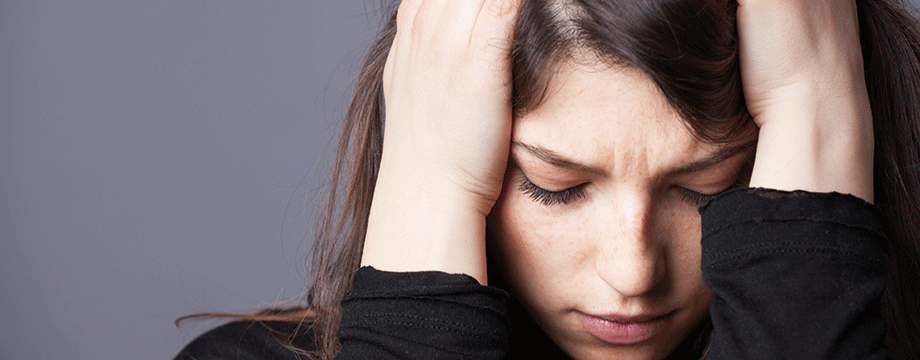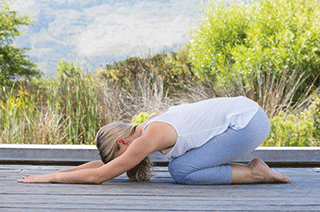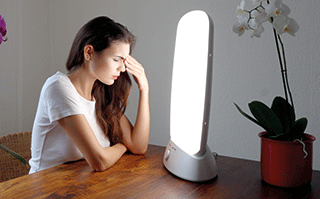Seeing the light

If you are one of the many sufferers of Seasonal Affective Disorder, these natural health tips and tricks could help
As the cold weather and darker days approach, summer can seem like a distant memory. Many of us will naturally feel the urge to hibernate and it can be hard not to feel a little gloomy. Up to 29 per cent of British adults are thought to suffer with Seasonal Affective Disorder, or SAD, with symptoms ranging from low mood, low energy levels, depression and anxiety to sleep problems, difficulty concentrating and eating more than usual.
“Although the causes of SAD are not fully understood, it is likely the reduction in daylight hours is the cause in susceptible individuals,” explains Claire Barnes, Technical Advisor and Nutritional Therapist with Protexin. “When the shorter days set in, it can disrupt our internal body clock and our hormone and neurotransmitter production, increasing our production of the hormone melatonin, which makes us feel sleepier whilst also reducing our levels of serotonin, a neurotransmitter which can affect our feelings of wellbeing.”
The feelgood chemical
“Antidepressants like Prozac work by keeping levels of serotonin (the ‘feel good’ brain chemical) adequate,” explains leading nutritionist Marilyn Glenville PhD, (www.marilynglenville.com). “The body makes serotonin from tryptophan. Tryptophan occurs naturally in foods such as dairy products, fish, bananas, dried dates, soya, almonds and peanuts. The manufacture of serotonin depends on how much tryptophan is transported into your brain. Combining the foods mentioned above with unrefined carbohydrates, such as brown rice, wholemeal bread or oats, helps the body to release insulin to help tryptophan uptake to the brain. A good example would be to eat eggs with wholemeal toast for breakfast.”
The sunshine vitamin
“When you get less sunlight, one of the vitamins that will help you improve levels of serotonin and make you feel happier, is vitamin D,” explains Frida Harju, in-house nutritionist at health and fitness app Lifesum (www.lifesum.com). “It also enhances the body’s absorption of other vitamins and minerals such as calcium, iron, magnesium, zinc and phosphate. Vitamin D deficiency can be a result of many different lifestyle factors, whether it’s through your diet or lack of absorption by the body, and lack of exposure to sunlight. Foods that provide vitamin D include:
- Salmon – this is the top hitter for vitamin D (wild salmon also has higher levels of vitamin D than farmed salmon). Just half a fillet of salmon has over 1,000 IU of vitamin D, which is more than the daily recommended allowance for a person.
- Milk/dairy products – opt for milk or dairy that has been fortified with vitamin D. You can also buy yogurts and other dairy products that have been fortified (these usually contain whole milk, not semi-skimmed). Ricotta cheese has more than five times the amount of vitamin D than other cheeses.
- Eggs – two large free-range eggs can hold about one-eighth of your recommended dose of vitamin D and also contain lots of other health benefits.
- Tuna – tinned fish, such as tuna or sardines contain over a quarter of the recommended amount.
- Tofu – one fifth of a block of raw tofu has 140 IU of vitamin D.
The gut/brain link
“Many experts recommend outdoor activities to increase the amount of daylight exposure and improve the mood,” says Claire Barnes. “Another consideration for SAD is the link between the gut and the brain. Recent studies have shown that improving the balance of the gut flora through live bacteria supplements can have a positive effect on mood and feelings of anxiety. Taking a multi-strain live bacteria supplement regularly throughout the year and especially through the autumn and winter months could be beneficial to rebalance the gut flora, which could possibly reduce the likelihood of developing SAD symptoms.”
St John’s Wort
“Studies have shown that St John’s Wort extract can be helpful in relieving the symptoms of SAD,” says Dr Dick Middleton, pharmacist and chair of the British Herbal Medicine Association (www.bhma.info). “St John’s Wort contains several chemicals, including hypericin, hyperforin, and flavonoids, and these are all now thought to be important for its activity.
Some research suggests that the herb acts to increase the availability of the brain chemicals serotonin, dopamine, and noradrenaline. These neurotransmitters help improve mood. Scientists thought that hypericin was responsible, but now they believe that other chemicals in St John’s Wort may be necessary for optimal activity. It is important to always choose a St John’s Wort product that displays the THR herbal medicine symbol that gives assurance of the quality of the product, and always read the in-pack leaflet before using.”
Yoga poses to combat SAD

“Treatments for SAD vary depending on the person, but 10 minutes of yoga per day is a great way to alleviate your mood, keep moving and to de-stress,” says Cheryl MacDonald, founder of YogaBellies (www.yogabellies.co.uk). “Not only does exercise improve your energy levels and mood, but studies have shown people with SAD who exercise are more likely to feel better about the ‘winter blues’.” Here, Cheryl suggests some yoga poses to help with Seasonal Affective Disorder:
1. Adho Mukha Svanasana (Downward-Facing Dog Pose)
The benefits of this pose are that it can help to ease any anxiety and helps to energise the body.
“Lie on your stomach with your palms by the sides of your chest with your fingers well spread. Come onto all fours position on your hands and knees. Place your knees directly below your hips and your hands slightly forward of your shoulders. Place one or two folded blankets in line with your breastbone. The blankets should be high enough to support your head, but low enough so that you can lengthen your neck. Come back to your hands and knees. Turn the toes under, and exhale as you raise your buttocks high in the air, moving your thighs up and back. Keep your elbows straight as you lift your buttocks up and release the crown of your head onto the support. The action of the arms and legs serves to elongate your spine and release your head. Hold for 30 seconds to 1 minute, breathing deeply.”
2. Urdhva Dhanurasana (Upward-Facing Bow Pose)
This pose helps to create a sense of calm, improves circulation and stimulates the nervous system.
“Place two yoga blocks against the wall, shoulder-width apart. Lie on your back with your head between the blocks, your knees bent, your feet hip-width apart, and your heels close to your buttocks. Bend your elbows and place your hands alongside your head with your fingers pointing toward your feet. As you exhale, raise your hips and chest, straighten your arms, and stretch your legs. Lift your tailbone and move the backs of your thighs toward your buttocks. Hold for 5 to 10 seconds if you can. If not, come in and out of it two or three times. To come out, bend your knees and elbows and slowly lower your body to the floor.”
3. Balasana (Child’s Pose)
This posture relaxes the spinal muscles and calms your nerves.
Kneel on the floor with your big toes touching and your knees slightly wider than your hips. Bend forward and stretch your arms and trunk forward. Rest your head on the floor or a blanket.”
Light box therapy

“A light box mimics outdoor light. Researchers believe this type of light causes a chemical change in the brain that lifts your mood and eases other symptoms of SAD,” explains Chris James, natural health and wellbeing expert (www.chrisjamesmindbody.com)). “Most people use light boxes for a minimum of 30 minutes each morning. Talk to your healthcare professional about light box options.
“Doctors recommend that you be under the care of a health care provider while using light box therapy. If you are experiencing both SAD and bipolar disorder, the advisability and timing of using a light box should be carefully reviewed with your doctor.”
Here are some questions to think about when buying a light box for SAD:
- Is the light box made specifically to treat SAD? If not, it may not help your depression.
- How bright is it? Look for a light box that provides the right intensity of light at a comfortable distance.
- How much UV light does it release? Light boxes for SAD should be designed to filter out most UV light. Look for a light box that emits as little UV light as possible. Contact the manufacturer for safety information if you have questions.
- Does it use LEDs? Traditionally, light boxes have used fluorescent or incandescent lights. Some manufacturers now sell light boxes with light-emitting diodes (LEDs).
- Does it emit blue light? Typically, light boxes use white light, but some light boxes give off blue light with a shorter wavelength. There is much more research available to support the use of bright white light to treat SAD than there is for blue light.
- Is it the style you need? Some light boxes look like upright lamps, while others are small and rectangular. You can even buy a battery-powered light therapy device attached to a visor, but it isn’t clear yet whether this type of light works as well as a standard light box. Because the effectiveness of a light box depends on daily use, it’s important to buy one that is convenient for you.
Soothing aromatherapy blends
“SAD can affect higher numbers of our population in the West than we might hitherto have recognised,” says Joannah Metcalfe, consultant aromatherapist with Base Formula (www.baseformula.com). “For those of us who do find the winter months challenging, aromatherapy can help to boost your mood, your circulation and your energy levels – naturally. Have regular aromatherapy massages with warming and mood-enhancing essential oils. Warming essential oils (rubifacients) include ginger, thyme, rosemary, frankincense, black pepper, plai and benzoin. Mood enhancers, particularly for depression/sadness, include ylang ylang, bergamot, rose and neroli – as well as the above. Make up aromatic baths with combinations of these oils too, and vaporise them at home, to help raise your spirits.”
Try the following aromatherapy blends:
Vaporising blend for an aromatherapy diffuser/oil burner: To warm, comfort and fight fatigue use two drops of ginger, six of sweet orange, two of black pepper and four of rosemary.
Aromatic bath/shower booster: to warm your body and lift your spirits mix 15ml SLS-free bath and shower gel, one drop of black pepper, two drops of rosemary, two of frankincense and six of bergamot.
Warming body lotion: To use after a bath or shower in the morning only (not before bed) to boost circulation and immunity: 150ml moisturising lotion, 10 drops of rosemary, eight of plai, eight of lemon, eight of cypress and 25 drops of lavender. Shake well before use and use regularly.
Read previous Your Health articles here...
Read articles from our latest issue here...